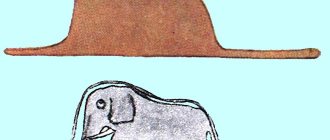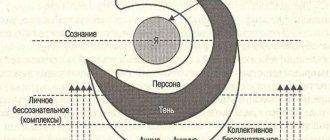Test to determine the dominant hemisphere of the brain
Which hemisphere of your brain is best developed and how does it help you, or, conversely, hinder you in life? It is known that the left hemisphere is responsible for logical, analytical thinking, and mathematical abilities. The right hemisphere is responsible for intuition, creative skills, imagination, emotions, artistic taste, and daydreaming. To pass this test, you will need to do a few simple experiments with your body. Interlace your fingers into a lock. If the thumb of your left hand remains at the top, then write the letter “L” on a piece of paper. If the thumb of the right hand is “P”. Imagine that you are aiming at a distant target. If you use your left eye and squint your right eye, then write the letter “L”, if on the contrary - “P”. Fold your arms across your chest. If your left hand is on top, then write “L,” if your right hand, then “P.” Clap your hands. If the left palm is more active, then put the letter “L”; if the right palm, then “P”. Test results If you get more letters “P”, then the left hemisphere dominates (since the left side responds to the right hemisphere , and the right one to the left). If you have more “L”, then your right hemisphere works better. That's not all. For an accurate personality analysis, you can also decipher your notes from letters. PPPP - you are 100% right-handed. In life you are guided by stereotypes. Conservative, non-conflicting. PPPL - your striking feature is indecision. PPLP - you are distinguished by artistry, you know how to flirt and joke. A determined person. PPLL - gentle character, excellent sense of humor, desire for development. PLPP - analytical mindset. Characterized by gentleness in communication, caution, coldness, and slowness. PLPL is a rare combination. Exposure to people's influence, defenselessness. LPPP - sociability, friendliness, sociability, emotionality, susceptibility to the influence of others. Lacks perseverance and perseverance. LPPL - naivety, gullibility, responsiveness, gentleness and the ability to compromise. LLPP - simple, friendly, prone to introspection, scattered in interests. LLPL - simplicity, generosity, tendency to self-sacrifice. LLLP - activity, energy, confidence, determination. LLLL - 100% left-handed. Non-standard thinking, creativity, pronounced creative abilities, pronounced individualism, selfishness. LPLP is a strong character type. Tenacity, perseverance, determination. It is difficult for a person to give in and he almost never changes his decision and point of view. LPLL - difficult to make friends, love of loneliness, tendency to introspection, determination, fortitude. PLLP - easy-going character, ability to resolve everything peacefully, lack of conflict, sociability and a wide range of interests. PLLL - desire for independence, inconstancy, independence.
Your psychologist. The work of a psychologist at school.
From neuropsychology, we know that the two hemispheres of the human brain work differently: the left hemisphere is responsible for the logical and linguistic aspects of mental operations, and the right hemisphere is responsible for their imagery, integrity and emotionality. This functional asymmetry of the human body manifests itself in different forms of behavior, while certain behavioral reactions can be built according to the right or left type.The proposed test is based on the position of the leading role of one of the hemispheres of the human brain. A so-called method of express character analysis has been developed, based on the functional asymmetry of the right and left hemispheres of the brain. Scientists have found that if the right hemisphere is dominant of the two hemispheres, then a person’s emotional sphere is more developed. If the left hemisphere is dominant, then the analytical mindset prevails over emotionality. The test uses four signs that are congenital and, as a rule, do not change until the end of life. However, it is necessary to take into account that with strong excitement the left hemisphere may become dominant instead of the right, and vice versa. And, of course, we must remember that there are no bad characters based on the left hemisphere, and bad characters based on the right hemisphere. This also applies to business people.
So you can do a few exercises and find out what types of reactions predominate in each of you. Prepare a sheet of paper and a pencil. After each task, you will record on a piece of paper which type of reaction - RIGHT or LEFT - manifested itself in you. They can be marked, for example, with the letters “P” and “l”.
Let's start the first task. Place your hands in front of you and interlace your fingers. Look which of the two thumbs is on top - the right or the left. If the right finger is on top, then this is the right type of reaction, so mark it on your sheet. If the left finger is on top, then your reaction type is left. Let's move on to the second task. Your eyes are open. Place your index fingers in front of your eyes as if you were aiming a gun, while catching and fixing with your eyes the point at which you are shooting (don’t close your eyes!). Now close first one and then the other eye. See which of these two cases causes the aiming point to move. If the point moves when your right eye is closed, then your reaction type is right, if the point moves when your left eye is closed, then your reaction type is left. Let's move on to the third task. This is the so-called Napoleon pose. Cross your arms over your chest and see which hand is on top, right or left. Record the result. Finally, the fourth task. First, applaud a little. Now pay attention to which hand is on top - right or left. Now record this result on your piece of paper. All tasks have been completed. By the number of right and left types of reaction, you can, to a first approximation, determine your type of interhemispheric asymmetry. The first task allows you to judge the general nature of your psychological makeup, whether it is logical or emotional. The second task can talk about character traits such as firmness and aggressiveness. Third, indicate a tendency towards simplicity or coquetry. Fourth - on decisiveness or indecisiveness of character. And here is a more detailed description of the types based on the test results: PPPP 1. Orientation towards generally accepted opinion (stereotypes), conservative type of character, the most stable (correct) behavior. PPpl 2. Uncertain conservatism, weak temperament. Indecisiveness. PPlP 3. Ability to coquetry, determination, sense of humor, activity, energy, temperament, artistry. When communicating with him, humor and determination are necessary, since this strong character does not accept weak types. PPll 4. Rare and independent type of character. Coquetry, sense of humor, gentleness, artistry. Some contradiction between indecision and strength of character. High contact, but slow addiction.
PlPP 5. Business type of character, combining an analytical mind and gentleness. More common in women. The generally accepted type of “business woman”. Slow addiction, caution. Such people never go into conflict head-on; they are dominated by calculation, tolerance, “viscosity,” slowness in the development of relationships, and a certain coldness. PlPl 6. The weakest character type, very rare. Defenselessness and weakness. Exposure to various influences. Occurs only in women. PllP 7. Tendency to new experiences and the ability not to create conflicts. Some inconstancy, the ability to flirt in an analytical manner, special gentleness. Emotional slowness, languor. Simplicity and rare courage in communication, the ability to switch to a new type of behavior. More common in women. Pllll 8. Fickle and independent character, the main feature is analyticalness. Rarely seen. lPPP 9. A common character type with very good adaptation to different conditions. Emotionality combined with insufficient persistence, which primarily manifests itself in basic strategic issues (marriage, education, etc.). High susceptibility to other people's influence. Easily communicates with all other character types. In men, emotionality is reduced and there is a tendency to be phlegmatic. lPPl 10. Weak persistence, gentleness, yielding to cautious influence, naivety. Requires a particularly careful attitude towards oneself - the “little queen” type. lPLP 11. The strongest type of character, difficult to convince. Able to show persistence, but sometimes it turns into “obsession” with secondary goals. Strong personality, energy, ability to overcome difficulties. Some conservatism due to insufficient attention to someone else's point of view. Such people do not like immaturity. lPll 12. Strong and unobtrusive character. Almost impossible to convince. The main feature is internal aggressiveness, covered with external softness and emotionality. Fast interaction, but slow mutual understanding. LLPP 13. Friendliness and simplicity, some dispersion of interests. llPl 14. Main features: innocence, gentleness, gullibility. This is a very rare type (1% of women, almost never found in men).
lllP 15. Emotionality combined with determination (the main feature), energy, and some scatteredness lead to the fact that such characters are capable of emotional, quickly made, ill-considered decisions. Therefore, additional “braking mechanisms” are important when communicating with them. lllll 16. The ability to take a fresh look at things (anti-conservatism), the greatest emotionality, individuality, selfishness, stubbornness, security, sometimes turning into isolation. The ability to smile dazzlingly.
Test results
Now count the number of “L” and “P” values. Enter them into the formula below. It's very simple!
(Subtract the number of “L” from “P”, divide the resulting number by 9 and multiply the result by 100%). For ease of calculation, use a calculator.
Colady illustration
More than 30%
Your LEFT hemisphere is dominant. This is where the speech center is located. It is not surprising that you love to talk, especially about things that you are good at. You take everything literally and have difficulty understanding the subtext. You have a penchant for exact sciences, mathematics, physics, etc. Get along with numbers and formulas. Logic is your main strong point.
Art often leaves you indifferent. You believe that there is no time to indulge in dreams when in the real world there is so much that is unsolved and alluring! You are very meticulous in details and like to delve into the essence of things. You have an excellent understanding of graphs, formulas and complex systems.
From 10 to 30%
You balance between left-brain and right-brain thinking, but the former predominates. This means that yesterday you admired a Beethoven symphony, and today you can easily solve an integral equation. You are a versatile person. You can delve into the essence of things both superficially and deeply.
Your communication skills are well developed. You easily convince different people that you are right. It is important for you to be understood and appreciated.
From – 10 to 10%
Incomplete dominance of the right hemisphere. Your thinking is more abstract. You are a sophisticated, dreamy person, but you never forget the need to rely on common sense. Always remember that the final result depends on your own efforts.
You are a very purposeful and consistent person in your actions and decisions. Many consider you the life of the party. You also have a phenomenal photographic memory, which means you can remember people’s faces and recognize them in a crowd.
Role of the right hemisphere
To be fair, I’ll start with the fact that both hemispheres of the brain are equally important and are almost equally responsible for all processes occurring in our body. But until recently, there was a widespread stereotype that the left hemisphere is responsible for more important functions, and the right lobe takes over the secondary ones. The author of this concept was the French anatomist, surgeon and ethnographer Paul Broca.
In 1864, using the scientific facts available at that time and personal experience, he discovered that the articulatory center of speech is located in the left lobe of the brain, that is, in the hemisphere that is opposite to the leading hand (in right-handed people). And the right side is responsible for intuition, which previously was nothing more than a myth. This led scientists to erroneous conclusions about the importance and secondary importance of the two hemispheres. By the way, it was for this reason that left-handed children were retrained to write with their right hand.
The modern concept regarding this issue has undergone significant adjustments. Today it is believed that each half of the brain is leading for certain mental functions. For example, the right hemisphere is more responsible for spatial-visual processes, while the left hemisphere is responsible for analytics. For this reason, the development of both hemispheres must be uniform, i.e. connecting.
So, what role does the right hemisphere of the brain take on to a greater extent:
- is responsible for processing nonverbal information in the form of pictures, symbols, signs, etc.;
- responsible for speech, metaphor, associations;
- responsible for recognizing faces, facial expressions, emotions and gestures;
- specializes in the perception of location and the whole, intuition and spatial orientation;
- responsible for the expression of feelings, fantasies, dreams, mysticism and religiosity;
- recognizes color, rhythm, abstractions;
- helps a person to create, endowing him with musicality, a penchant for poetry, painting, dancing, etc.
Learn what cognitive abilities are and how to develop them.
Exercises to develop the right lobe of the brain
Below I will give several techniques that will help make the right hemisphere more active.
Drawing in “P-mode”
The right-hemisphere drawing technique was developed by Doctor of Science Betty Edwards in 1979. The principle of “P-mode” is the deliberate suppression of the left hemisphere.
Here are some ways:
- Take a coloring book or print out the outline drawing yourself and turn the sheet upside down. Then duplicate this image on a separate blank sheet of paper. An inverted drawing will deprive you of the opportunity to draw the whole image and will force you to copy every line.
- Arm both hands with pencils or markers and draw something on a piece of paper, using both hands at the same time.
- This method is similar to the previous one, only here you do not need to draw from scratch, but trace the finished picture with both hands.
More than 100 cool lessons, tests and exercises for brain development
Start developing
Game gymnastics
These exercises are suitable for the development of the right hemisphere in a small child or teenager.
- ring
The task is to alternately connect the fingers on your left hand into a ring. First the thumb with the index finger, then the thumb with the middle, ring and little fingers. And then do the same thing, only in reverse order. Gradually, the speed of changing fingers should increase. The next level of difficulty is to connect your fingers into a ring at the same time on both hands.
- Captain
Starting position - the right hand is placed over the eyebrows with a visor, and the left one shows a thumbs up. Then the hands change places. A more difficult task - clap between hand positions.
- Fist – edge – palm
The child alternately clenches his fist, then places his palm edge-on on the table, and then places his hand palm down. First, all this needs to be done with the left hand, then with the right, and then with both hands together, gradually accelerating the pace.
- Left hand work
The name is the whole essence of the exercise. If the child is right-handed, you need to draw and write with your left hand, and if you are left-handed, then with your right. Adults can also practice this way, for example, stirring tea or brushing their teeth with an unfamiliar hand.
- Alphabet
Take a blank sheet of paper and write the entire alphabet in large font, leaving spaces between the letters. Now go through the entire alphabet, alternately putting under the letters L, P and V. Under the letter A we put L, under the letter B - P, under the letter B - C, under the letter G - again L. And so on.
Now the child must name the letters one by one and perform actions in accordance with the signatures under the letters, where L means raising his left hand, R - raising his right hand, V - raising both hands together. Thus, the child calls the letter A and raises his left hand, then lowers it, says B and raises his right, etc. Having reached the end of the alphabet, you need to say everything in reverse, that is, from Z to A.
- Colors
Write the names of the colors and shades on the sheet, using for each a color pencil or felt-tip pen that does not match the name. For example, we write the word “red” with a green pencil, and “blue” with a yellow pencil. The task is to name the colors in which the words are written as quickly as possible and without errors.
You may find motor skills games useful.
Imaginative training
To perform the following exercises, you will need to close your eyes and tune in to visualization:
- Imagine a white sheet of paper in your mind and mentally write your name on it. Then change the color of the letters. If possible, try changing the background of the paper.
- Visualize tactile, olfactory and taste sensations. For example, imagine eating an apple, hearing the sound of a piano, or touching a cat's fur. Examples can be anything.
- Remember any song. Recreate in your head the exact motive, music, words, voice of the performer.
Find even more techniques and exercises for developing your imagination on our blog.
Other methods
You can develop the creative half of your brain using other methods. For example:
- attend exhibitions, theaters, concerts;
- write essays, poems;
- read literature;
- participate in home performances or attend a drama club.









